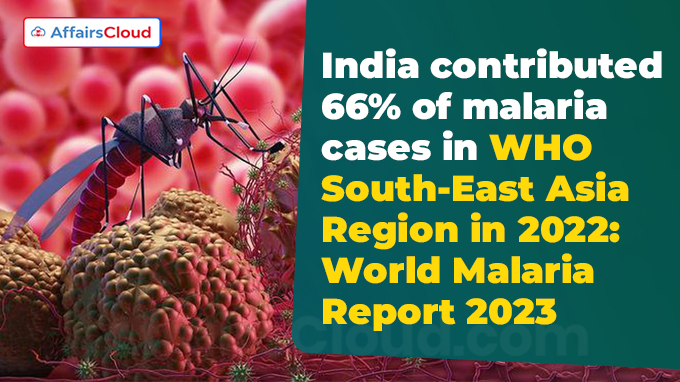 As per the 2023 World Malaria Report by the World Health Organization (WHO), India constituted 66% of malaria cases in the WHO’s South-East Asia region in 2022. Despite an overall decrease of 11.9% in estimated cases between 2021 and 2022 in the region, Bangladesh, Indonesia, Myanmar and Thailand recorded an increases in cases.
As per the 2023 World Malaria Report by the World Health Organization (WHO), India constituted 66% of malaria cases in the WHO’s South-East Asia region in 2022. Despite an overall decrease of 11.9% in estimated cases between 2021 and 2022 in the region, Bangladesh, Indonesia, Myanmar and Thailand recorded an increases in cases.
- Plasmodium vivax(P. vivax), a protozoal parasite, contributed to almost 46% of cases in the region.
- Notably, India and Indonesia accounted for about 94% of all malaria deaths in South-East Asia region in 2022.
Note:
i.Malaria is an acute febrile illness caused by Plasmodium parasites, which are spread to people through the bites of infected female Anopheles mosquitoes.
ii.The annual World Malaria Report by WHO assesses global trends in malaria control and elimination.
Highlights:
i.Around 249 million malaria cases have been reported around the world(in 85 malaria endemic countries and areas) which exceeded the pre-pandemic count of 233 million in 2019.
ii.Covid-19 disruptions, drug resistance, humanitarian crises, and climate change pose threats to the global malaria response.
iii.29 countries accounted for 95% of malaria deaths globally.
- 4 countries, Nigeria (27%), the Democratic Republic of the Congo (12%), Uganda (5%), and Mozambique (4%), accounted for almost half of all malaria deaths globally in 2022.
iv.Africa has the highest malaria burden, accounted for 94% of cases and 95% of global malaria deaths in 2022.
Key Points:
i.In the WHO South-East Asia Region, including India, managed to contain malaria over the last two decades, with a 77% reduction in cases and deaths since 2000.
ii.Global technical strategy for malaria- 2016–2030 (GTS) calls for a reduction in malaria case incidence and mortality rate of at least 40% by 2020, 75% by 2025 and 90% by 2030 from a 2015 baseline.
iii.Funding gaps for malaria control increased from USD 2.3 billion in 2018 to USD 3.7 billion in 2022. The Research and development (R&D) funding hit a 15-year low at USD 603 million.
iv.Progress in malaria prevention involves the phased introduction of the WHO-recommended RTS,S/AS01 vaccine in African nations, and in October 2023, the WHO recommended a second safe and effective malaria vaccine, R21/Matrix-M.
v.WHO urges a significant shift in the malaria fight, stressing the importance of more resources, stronger political commitment, data-driven strategies, and innovative tools.
Recent Related News:
i.WHO has recommended R21/Matrix-M, the new malaria vaccine developed by
Jenner Institute at Oxford University(the United Kingdom -UK) and Serum Institute of India (SII) Private Limited leveraging Novavax’s adjuvant technology, for the prevention of malaria in children.
ii.World Anti-Doping Agency (WADA) and WHO have recently inked a four-
year Memorandum of Understanding (MoU) that enables experts from both global organizations to work together and exchange information concerning areas where the realms of anti-doping and public health intersect.
About World Health Organisation (WHO):
Director General – Tedros Adhanom Ghebreyesus
Headquarters – Geneva, Switzerland
Establishment– 1948




